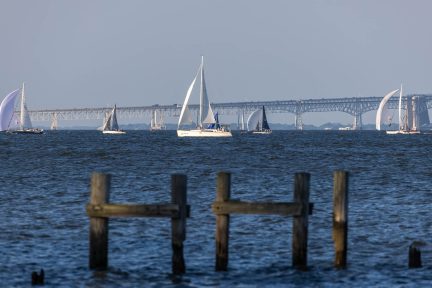2021 Blue Crab Advisory Report Released
2021 Blue Crab Advisory Report Released
The Chesapeake Bay Program is pleased to release the 2021 Blue Crab Advisory Report, which finds that the overall Chesapeake Bay blue crab population is not being overfished and is not depleted. Experts from the Chesapeake Bay Stock Assessment Committee reviewed the results from the annual Bay-wide Winter Dredge Survey (released in May 2021 by the Maryland Department of Natural Resources and the Virginia Institute of Marine Science) and harvest figures from the previous seasons to provide an in-depth picture of the Chesapeake’s blue crab population and to make suggestions for any needed changes to regulations.
The Winter Dredge Survey found that the blue crab population (males and females alike of all ages) in the Bay—which varies naturally from year to year—decreased from 405 million in 2020 to 282 million in 2021. Experts attribute this decline to be in large part due to the juvenile blue crab population—crabs that will grow to harvestable size next year—which is estimated to be 86 million, down from 185 million in 2020. Managers will monitor the status of these populations over the summer, adjusting regulations if needed.
The stock of male adult blue crabs (ages 1+) was estimated to be 39 million in 2021, a decline from the approximately 79 million in 2020. In 2021, the population estimate of adult females increased to 158 million from 141 million in 2020. This number is above 72.5 million, which is the minimum acceptable level for female blue crabs in the Bay, but lower than the target of 196 million. In the 2020 blue crab fishing season, 19% of all female crabs were harvested—safely below the science-based target (28%) and threshold (37%) levels for the 13th consecutive year. Resource managers focus on maintaining a healthy stock of female crabs to ensure continued resiliency of the population in this and future years.
The 2021 Advisory Report recommends:
- Researchers should explore the environmental factors that may contribute to the highly variable nature of the blue crab population.
- The Maryland Department of Natural Resources, Potomac River Fisheries Commission and Virginia Marine Resources Commission should implement programs to track commercial and recreational harvest more accurately, including the use of electronic reporting systems.
The Blue Crab Advisory Report is developed by the Chesapeake Bay Stock Assessment Committee, a group of experts from state and federal agencies and academic institutions. The blue crab fishery in the Chesapeake Bay is managed by the Maryland Department of Natural Resources, Virginia Marine Resources Commission and Potomac River Fisheries Commission.
Facts
The Blue Crab Abundance outcome in the Chesapeake Bay Watershed Agreement is designed to maintain a sustainable blue crab population; the Blue Crab Management outcome promotes collaboration between the Chesapeake Bay Program and stakeholders to work toward a stable and productive blue crab fishery.
In November 2020, the Chesapeake Bay Stock Assessment Committee adopted new biological reference points for the blue crab population, based on a stock assessment update conducted in 2017. The revised reference points include new targets—196 million—and new thresholds—72.5 million—for female abundance and exploitation, which indicates that the population is healthy and has improved since the previous assessment in 2011. These new reference points were used to assess the blue crab population status for the first time in the 2021 Blue Crab Advisory Report.
Issues
Blue crab populations in the Chesapeake Bay can vary naturally from year to year, based on weather and other environmental conditions, as well as how many are caught. Commercial fishermen rely on having a steady supply of crabs in the Bay, and recreational crabbers enjoy being able to catch crabs. Scientific analysis, like that included in the Blue Crab Advisory Report, helps resource managers make decisions that promote a sustainable supply of crabs.
Importance
Blue crabs are an important part of the ecology and economy of the Chesapeake Bay. They serve as food sources for the Bay’s fish and bird populations and support a large recreational and high-value commercial fishery. The blue crab harvest declined across the Chesapeake Bay during the 2020 crabbing season, in response to a smaller market due to reduced restaurant patronage during the Covid-19 pandemic. Commercial fishermen harvested approximately 41.6 million pounds of blue crabs from the Bay and its tributaries in 2020, down from the 61 million pounds harvested in 2019. Recreational crabbers harvested an estimated 2.4 million pounds in 2020, a decrease from the 3.8 million pounds harvested in 2019.
Quotes
“All of us who love blue crabs benefit from the science-based analysis and discussion in the Blue Crab Advisory Report. The report helps state resource managers set limits that leave enough crabs in the Bay to ensure healthy harvests for years to come.”
- Sean Corson, Director, NOAA Chesapeake Bay Office and Chair, Sustainable Fisheries Goal Implementation Team
“Using data from the 2017 blue crab stock assessment update really helps us be more precise with our new female-specific reference points. Being able to update the stock assessment on a regular basis allows the Chesapeake Bay Stock Assessment Committee to evaluate the performance of the model with the most recent information. This allows us to make management decisions based on what is going on in the fishery now, compared to using information gathered for the 2011 benchmark assessment.”
- Patrick Geer, Chief, Fisheries Management Division, Virginia Marine Resources Commission and Chair, Chesapeake Bay Stock Assessment Committee
“While a robust spawning stock was a good indicator that management is working, the low level of juvenile and male crabs is reason for concern, and those segments of the population will need to be closely monitored throughout the crabbing season.”
- Mike Luisi, Director, Monitoring and Assessment Division, Fishing and Boating Services, Maryland Department of Natural Resources
“We agree with our jurisdictional partners that female abundance, the cornerstone for management of the fishery, continues to be healthy. At the same time, we share the concern over the low abundance of juveniles. PRFC has approved status quo measures for this season and will monitor how juvenile crabs are doing this summer. Working with the other jurisdictions on blue crabs ensures a coordinated approach.”
- Marty Gary, Executive Director, Potomac River Fisheries Commission



